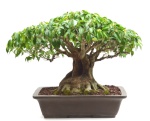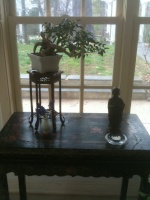Excerpt from the poet Gong Zizhen (1792-1841)
5 posters
Page 1 of 1
 Excerpt from the poet Gong Zizhen (1792-1841)
Excerpt from the poet Gong Zizhen (1792-1841)
I thought the following would be interesting to share. It is an English translation from a Chinese colleague of mine who knows of my interest in bonsai. From what he has read about the art during his life, the practice of bonsai in China became less popular for a time after Gong Zizhen, a famous poet, wrote this short note about it:
"My Sick Plum Chamber"
"Longpan in Nanjing, Mount Dengwei outside Suzhou and Xixi near Hangzhou are all noted for their plum trees. Someone say plum trees look best gnarled, lacking charm when straight; or look best lop-sided, being not worth a glance upright; or best when sparse, lacking form when luxuriant. Of course, this is what literati and connoisseurs think, but it should not be proclaimed as a binding rule for all plum trees in the world; nor should everyone be required to chop down straight trees, cut back the luxuriant and root out those growing upright, to make a living out of killing and deforming plum trees. Making plum trees lop-sided, sparse or gnarled was not something that could be dreamed up by dolts out to make money; but those who sell plum trees have been told about the eccentric tastes of literati and artists; so they chop off the main branches but keep the offshoots, cut back luxuriant growth and kill tender sprigs, root up straight trees and sap their vitality - all in order to fetch high prices. As a result, all the plum trees in Jiangsu and Zhejiang are deformed; so fearful is the destruction caused by these literati and artists!
I bought three hundred potted plums, all deformed, not a single whole one among them. For three days I wept over them, then vowed to cure them. I loosened and straightened the branches, smashed the pots, united the coir drops round the trees and planted them in the ground, determined to nurse them back to health within five years. Not being an artist or one of the literati, I will gladly put up with abuse for setting up this infirmary for deformed plum trees. My one regret is that I have not more time to spare, more land lying idle, for all the stunted plums of Nanjing, Hangzhou and Suzhou, so that I can devote my whole life to curing them! "
Regards,
Tom Simonyi
"My Sick Plum Chamber"
"Longpan in Nanjing, Mount Dengwei outside Suzhou and Xixi near Hangzhou are all noted for their plum trees. Someone say plum trees look best gnarled, lacking charm when straight; or look best lop-sided, being not worth a glance upright; or best when sparse, lacking form when luxuriant. Of course, this is what literati and connoisseurs think, but it should not be proclaimed as a binding rule for all plum trees in the world; nor should everyone be required to chop down straight trees, cut back the luxuriant and root out those growing upright, to make a living out of killing and deforming plum trees. Making plum trees lop-sided, sparse or gnarled was not something that could be dreamed up by dolts out to make money; but those who sell plum trees have been told about the eccentric tastes of literati and artists; so they chop off the main branches but keep the offshoots, cut back luxuriant growth and kill tender sprigs, root up straight trees and sap their vitality - all in order to fetch high prices. As a result, all the plum trees in Jiangsu and Zhejiang are deformed; so fearful is the destruction caused by these literati and artists!
I bought three hundred potted plums, all deformed, not a single whole one among them. For three days I wept over them, then vowed to cure them. I loosened and straightened the branches, smashed the pots, united the coir drops round the trees and planted them in the ground, determined to nurse them back to health within five years. Not being an artist or one of the literati, I will gladly put up with abuse for setting up this infirmary for deformed plum trees. My one regret is that I have not more time to spare, more land lying idle, for all the stunted plums of Nanjing, Hangzhou and Suzhou, so that I can devote my whole life to curing them! "
Regards,
Tom Simonyi

Tom Simonyi- Member
 Re: Excerpt from the poet Gong Zizhen (1792-1841)
Re: Excerpt from the poet Gong Zizhen (1792-1841)
Hi Tom,
Thank you for posting.
I enjoyed very much.
Thank you for posting.
I enjoyed very much.

Jeremy- Member
 Re: Excerpt from the poet Gong Zizhen (1792-1841)
Re: Excerpt from the poet Gong Zizhen (1792-1841)
A man who knew his own mind or a contrarian .....?
Interesting post....................
Interesting post....................

charlesryder- Member
 Re: Excerpt from the poet Gong Zizhen (1792-1841)
Re: Excerpt from the poet Gong Zizhen (1792-1841)
Thanks for sharing this. As they say ... "to each, their own".

Todd Ellis- Member
 Re: Excerpt from the poet Gong Zizhen (1792-1841)
Re: Excerpt from the poet Gong Zizhen (1792-1841)
Tom,
Thank-you very much for bringing this to our attention.
Because there was only a stub of an article about Gong on Wikipedia this morning, I've taken the liberty of fleshing it out, http://en.wikipedia.org/wiki/Gong_Zizhen .
What is striking about your excerpt is that I've come across very few other criticisms of dwarfed potted trees down through the ages of China and Japan. So it has historical value in that sense. It is true that when you look at old prints and photos of penjing/bonsai, the plums stand out not because of a delicate "feminine" appearance, but because of their characteristic chopped stylings. Examples can be seen about a third of the way down here, http://www.phoenixbonsai.com/1900Refs/OtherPhotos.html, and in the 1770's section, about three-quarters of the way down here, http://www.phoenixbonsai.com/Paintings/JapanPortrayals.html .
Robert J. Baran
Bonsai Researcher and Historian
Thank-you very much for bringing this to our attention.
Because there was only a stub of an article about Gong on Wikipedia this morning, I've taken the liberty of fleshing it out, http://en.wikipedia.org/wiki/Gong_Zizhen .
What is striking about your excerpt is that I've come across very few other criticisms of dwarfed potted trees down through the ages of China and Japan. So it has historical value in that sense. It is true that when you look at old prints and photos of penjing/bonsai, the plums stand out not because of a delicate "feminine" appearance, but because of their characteristic chopped stylings. Examples can be seen about a third of the way down here, http://www.phoenixbonsai.com/1900Refs/OtherPhotos.html, and in the 1770's section, about three-quarters of the way down here, http://www.phoenixbonsai.com/Paintings/JapanPortrayals.html .
Robert J. Baran
Bonsai Researcher and Historian

Robert J. Baran- Member
Page 1 of 1
Permissions in this forum:
You cannot reply to topics in this forum






